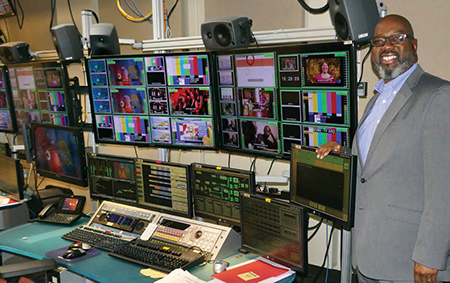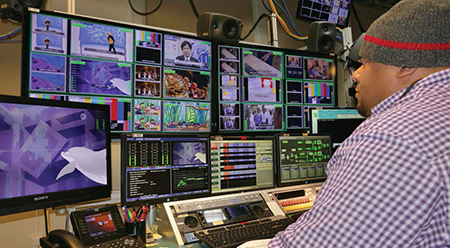Multiviewers: There’s No Turning Back
ALEXANDRIA, VA.—In the professional television industry, many things have changed over the past 20 years. In studios worldwide, one of the most visible changes is the monitoring revolution caused by the convergence of multiviewers and large low-cost flat-screen displays.

Renard Jenkins, vice president of operations for PBS, shows off one of the network’s master control pods. The combination of these two recent technologies provided a completely new look for control rooms and made individual displays obsolete practically overnight.
At PBS’s network control in Alexandria, Va., there are multiple monitoring pods built around pairs of large displays, with each display showing 18 images of various sizes, each identified with its source name. Multiple pods can be used to monitor the network’s activity, including ingests and feeds to its member stations.
However, a pod in the corner has a special task: It is identical to and in constant communication with another pod in a Midwestern city, where the network’s control can be switched in the event of a disaster. Called the “Diversity Disaster Maintenance System,” a multiviewer at either end packages the video streams onto a private Ethernet line that runs between Alexandria and the Midwestern city.
“It’s important for us that we can see all the activity that’s happening, either from a playout standpoint or an uplink standpoint,” said Chris Homer, vice president of engineering for PBS. “This is our first foray into an IP broadcast infrastructure. It’s a very inexpensive way to get lots of channels onto a single monitor.”
At PBS’s main monitoring pods, the network typically manages 14 broadcast feeds simultaneously. Each of the main pods are configured to monitor these signals, with each video image paired with an audio level indicator. Any individual signal can be called up for closer scrutiny on a solo display, as well as inspecting it on a waveform monitor.

Apantac LI multiviewer “The multiviewer allows us to see all of those channels, and it also allows us to make sure that we have captions and that the audio is monitored,” said Renard Jenkins, vice president of operations for PBS. “One person cannot watch and listen to all 14 channels at the same time, but visually you can see that you have everything that you’re supposed to have on the channels. It also allows us to change this layout based on, say, a live event in which we set our number one channel to the live event. But we still have to pay attention to all those other channels.”
The professional video industry's #1 source for news, trends and product and tech information. Sign up below.
DIGITAL DISTRIBUTION
In the future, Jenkins said that the network plans to use multiviewers to monitor some of its digital distribution paths, such as OTT playout through iTunes, Hulu and other distributors.
“Wouldn’t it be great if we could actually use a multiviewer to see what’s going on the down end of that,” he said. “Pull up one of our on-demand things and take a look at it. If we see something on our side that the aggregator didn’t catch, we can make that repair then give them a call to resubmit this because we noticed “X” during playback.”
There are many manufacturers of multiviewers that service the needs of professional television facilities. Making a wide range of products to serve a spectrum of needs, multiviewer processors are available from small standalone desktop boxes to complex rackframe systems.
Of course, a multiviewer’s output is viewed on a display, so what do multiviewer manufacturers suggest for the optimum displays?
“There are several features that users should look for in 4K/UHD displays, although display manufacturers do not always divulge all the detailed specifications, and often the customer will need to dig into the specs on their own,” said Thomas Tang, president of Apantac. “The following points are what the customer should keep in mind when choosing a 4K/UHD display:
When the display specifications state HDMI 2.0, you should ask whether it supports 4:2:2 or 4:2:0 at 60 Hz. Some displays support HDMI 2.0 in 4:2:2, but only at 30 Hz. This can make a big difference in quality.
If you need 4K/UHD in 4:2:2 at 60 Hz, the display may support this specification in DisplayPort rather than HDMI 2.0.
When the display supports DisplayPort in 4:2:2 at 60 Hz, is it SST or MST? This may determine whether the image will show up on the display or not.

Operations Technician Rodney Fitzgerald keeps an eye on the network feeds at PBS’s control facility in Alexandria, Va. Is the display 4K or UHD? 4K is 4,096 x 2,160 pixels; UHD is 3,840 x 2,160 pixels. This feature can make a big difference in price.”
“Due to fierce competition, display manufacturers in the consumer and prosumer markets are in perpetual price wars that makes the technology affordable,” said Jesse Foster, director of products & business development for Cobalt Digital Inc. “They continue to introduce enhanced capabilities that have positive implications for the professional user such as high frame rate, wide color gamut and high dynamic range. The advancement of the HDMI 2.0 standard used in the consumer space already brings support for 3,840 x 2,160-pixel displays at 60 fps, and the professional market will see the ST-2082 12G-SDI standard being offered in broadcast- and reference-grade monitors.”
WELL-DEFINED NEEDS
If the past two decades have taught us anything, it is that change is inevitable. Although you may have well-defined multiviewer needs today, that could change dramatically in a year or two.
“Television facilities should look for a multiviewer that is flexible enough to support demanding workflows now, as well as equipped with future-proof tools to expand and grow with a facility’s needs,” said Bob Caniglia, senior manager for key accounts at Blackmagic Design. “Facilities should invest in a multiviewer that is native Ultra HD with multi-rate 6G-SDI inputs with full frame re-synchronization and separate loop-through outputs, making it compatible with existing equipment. This will also allow the multiviewer to support any combination of SD, HD and Ultra HD formats and frame rates all at the same time, on the same display, further enhancing flexibility. A multiviewer should also supply the technical features that facilities need, such as audio meters, custom view labels, tally indicators and more.”
“Customers are looking for a multiviewer being able to monitor SD, HD, 3G and 4K signals, with ability to expand the system as facility grows,” said Ketan Patel, product manager for multiviewer systems at Evertz.
Patel pointed out that digital streams will increasingly be part of what a multiviewer must handle, in addition to SDI. These include uncompressed-over-IP and compressed signals such as MPEG2, H.264, HEVC and JPEG2000.
There are many manufacturers of multiviewers in addition to the companies mentioned above. These include Grass Valley, Imagine Communications, Craltech, Decimator Design, Matrox, Mividi, Swit and Kramer.
A modern control facility could be built without using a multiviewer, but it would be expensive, inefficient and inflexible. Some technologies represent the promise of the “better mousetrap”—going back to the way it was before multiviewers is simply inconceivable.
Bob Kovacs is the former Technology Editor for TV Tech and editor of Government Video. He is a long-time video engineer and writer, who now works as a video producer for a government agency. In 2020, Kovacs won several awards as the editor and co-producer of the short film "Rendezvous."

